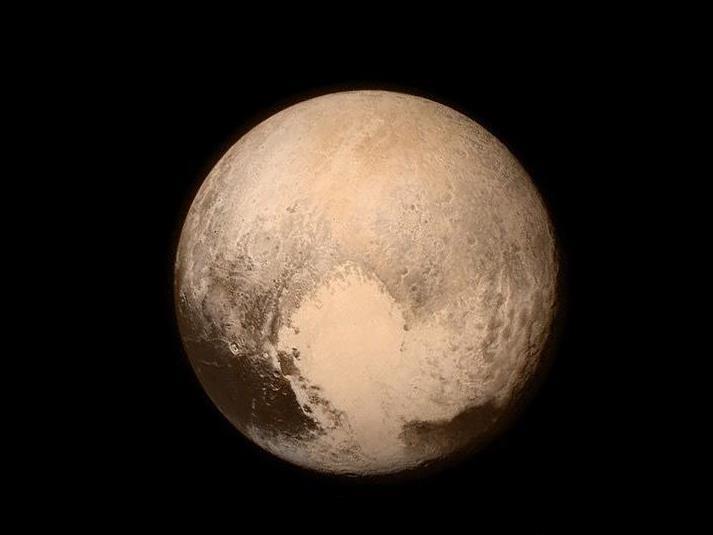Pluto photographed by the New Horizons spacecraft; photo via wellesley.edu
Fans of astronomy who also have a musical bent may have experienced a “what if” moment this week. With NASA’s New Horizons currently thrilling the world with the best ever images of the dwarf planet, it would have been the perfect time to bust out a recording of Gustav Holst’s symphonic suite, The Planets, and propose a toast to Pluto.
Unfortunately, Holst didn’t write a movement for Pluto. Exactly one hundred years ago, Holst was half way through composing what would become his most famous work, but Pluto wasn’t discovered until 1930, four years before the composer’s death.
Holst was apparently disinterested in updating his planetary audio tour, slightly resenting the work’s popularity and the corresponding attention deficit afforded his other compositions.
Resentment may have given way to pride had he known just how influential and ubiquitous The Planets would become, especially in cinema.
The Imperial March from Star Wars, for example, was clearly based on Mars, The Bringer of War, the first movement in the video of The Planets above. Not so much as stealing, John Williams was probably honouring George Lucas’s request to recreate the spirit of Holst – an acknowledgement of the grip Holst’s music has on the public’s imagining of outer space.
The fact that Holst was actually composing music based on astrologically inspired themes rather than astronomical (hence no “Earth” movement) is curiously beside the point now – we are so used to hearing this music appropriated for the purpose of making imagined outer space audible.
Humans have always turned to music to help deal with the profoundly confronting enormity of the cosmos.
From humming Twinkle Twinkle Little Star to a child at bedtime while peering through the window at the night sky, to Stanley Kubrick exploiting the raw power of Strauss and the luminous intricacy of Ligeti in 2001: A Space Odyssey, somehow music and the cosmos go together.
One of the most emotionally-resonant items aboard NASA’s Voyager 1 spacecraft, on its interstellar journey, is of course the Golden Record, with its extensive and diverse musical selection.
The 90-minute sampling of music from around the globe is hardly tokenistic, and it implies that humanity regards music as a very good foot to put forward when sending messages to alien civilisations.
The Music of the Spheres
This is all nothing new – music and astronomy have been intimately linked since antiquity.
An inaudible expression of mathematics via harmony, the Music of the Spheres was thought to determine the celestial dance moves of the planets and moons.
It all stemmed from Greek mathematician Pythagoras’ discovery that pitch is proportionally related to the length of the sounding body such as a string or air column, and that what humans perceive as “harmonious” sounding intervals (two pitches sounding at the same time) corresponded with simple mathematical ratios.
Pythagoras’ 2,600-year-old suggestion that planetary bodies emit a kind of orbital hum may have been off the mark in terms of function (believing the inaudible vibrations affected everyday life on Earth) but not in substance.
Translations of radio and electromagnetic waves from space into audible sound make for eerie listening.
The pioneering American composer Terry Riley wrote an evening-length composition based on sounds collected from across the solar system in collaboration with a scientist and the Kronos string quartet:
You can even listen to a live performance by space 24 hours a day, seven days a week if you so desire, or a playback of all radio waves that have travelled away from Earth since we began transmitting radio.
Despite this history of recruiting our aural imagination to help get our minds around space, I do wonder what kind of humanly-constructed sound could actually do Pluto justice.
Rejected for a time by size-ist scientists, invited back on new terms, and for many ever-associated with a cute dog cartoon by Disney, the sheer mysteriousness of Pluto is somewhat obscured by the jokes.
So many educational posters line the planets up like snooker balls, for eminently practical reasons, that our sense of Pluto’s vast distance from us is rarely accurate.
A recent video on Vox explains that if Earth were the size of a basketball, then Pluto would be a golf ball. Maintaining that scale, the two objects would have to be more than 80 kilometres apart to accurately reflect how far away Pluto is.
Words like “cold” and “lonely” don’t seem to capture the devastating isolation Pluto endures, a vantage point from which the sun appears as a not much more than a bright star.
The visionary German composer Karlheinz Stockhausen wasn’t afraid to venture past Pluto, into deep musical space, and his mid-1970s musical drama Sirius brings us some fantastically original and imaginative sounds courtesy of four emissaries from a planet orbiting Sirius. The extensive use of electronically generated sounds in addition to the live performers gives this music its unearthly quality.
A lonely planet
At least one composer has taken up the challenge to complete Holst’s Planets, but his version of Pluto was designed to work well in a complete performance of the original suite, more or less connected to the planets-as-astrology approach of Holst.
Are there undreamt-of sounds lurking in humanity’s various musical languages that could truly evoke Pluto-ness in all its mind-bending solitude? Will even deeper relationships between sound and space be discovered by scientists?
I suspect the answers will be yes, and I can’t wait to hear what the music will be like.
This article was originally published on The Conversation. Read the original article.





